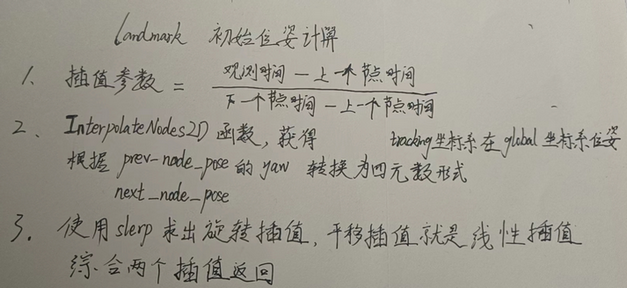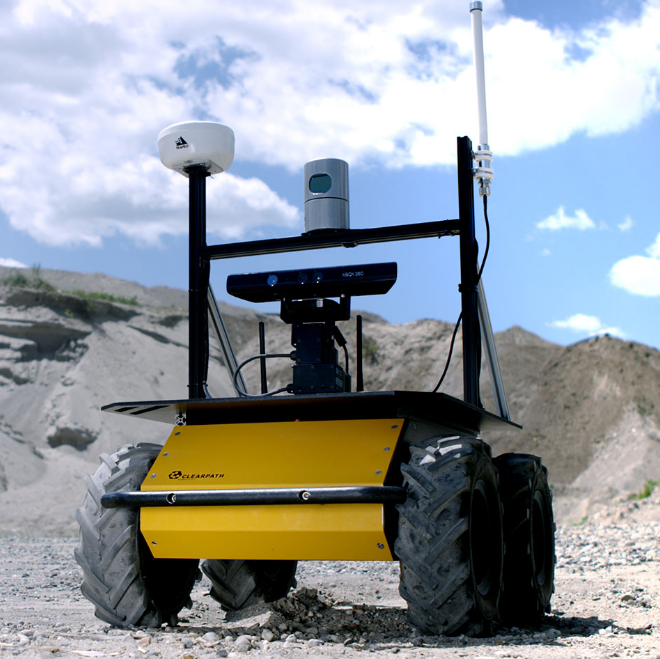加入landmark后,Pose Graph有了不同的node和edge,也就是landmark也作为node,landmark-pose之间的 edge是新的一种edge,即在pose对landmark的观测
1 | struct LandmarkNode { |
landmark是应用于后端,不是实时的,应当调大权重让carto更相信它的结果
添加数据部分1
2
3
4
5
6
7
8
9
10
11
12
13
14
15
16
17
18
19
20
21
22
23
24
25
26
27void PoseGraph2D::AddLandmarkData(int trajectory_id,
const sensor::LandmarkData& landmark_data)
{
AddWorkItem([=]() LOCKS_EXCLUDED(mutex_) {
absl::MutexLock locker(&mutex_);
if (CanAddWorkItemModifying(trajectory_id)) {
for (const auto& observation : landmark_data.landmark_observations)
{
// initial landmark_nodes
// const transform::Rigid3d global_pose =
// observation.landmark_to_map_transform;
data_.landmark_nodes的类型是 std::map<std::string /* landmark ID */, PoseGraphInterface::LandmarkNode>
data_.landmark_nodes[observation.id].landmark_observations.emplace_back(
PoseGraphInterface::LandmarkNode::LandmarkObservation{
trajectory_id, landmark_data.time,
observation.landmark_to_tracking_transform,
observation.translation_weight, observation.rotation_weight} );
// data_.landmark_nodes[observation.id].global_landmark_pose = global_pose;
}
}
// optimization_problem_->new_landmark_add_ = true;
return WorkItem::Result::kDoNotRunOptimization;
});
}
这里就是把观测到的landmark信息都保存到data_.landmark_nodes,最后返回的标识也是不优化
后端优化的流程和其他传感器数据一样:PoseGraph2D::HandleWorkQueue —— PoseGraph2D::RunOptimization —— OptimizationProblem2D::Solve(data_.constraints, GetTrajectoryStates(), data_.landmark_nodes) —— AddLandmarkCostFunctions(landmark_nodes, node_data_, &C_nodes, &C_landmarks, &problem, options_.huber_scale() )
OptimizationProblem2D::Solve部分:1
2
3
4
5
6
7
8
9
10
11
12
13
14
15
16
17
18
19
20
21
22
23
24
25
26
27
28
29
30
31
32
33
34
35
36
37
38
39
40
41
42
43
44
45
46
47
48
49
50
51
52
53
54
55
56
57
58 std::set<int> frozen_trajectories;
for (const auto& it : trajectories_state)
{
if (it.second == PoseGraphInterface::TrajectoryState::FROZEN)
{
frozen_trajectories.insert(it.first);
}
}
ceres::Problem::Options problem_options;
ceres::Problem problem(problem_options);
// Set the starting point. TODO(hrapp): Move ceres data into SubmapSpec.
// ceres需要的是double指针,std::array 能转成原始指针的形式
MapById<SubmapId, std::array<double, 3>> C_submaps;
MapById<NodeId, std::array<double, 3>> C_nodes;
std::map<std::string, CeresPose> C_landmarks;
bool first_submap = true;
// 将需要优化的 子图位姿 设置为优化参数
for (const auto& submap_id_data : submap_data_) {
// submap_id的轨迹是否是冻结的
const bool frozen =
frozen_trajectories.count(submap_id_data.id.trajectory_id) != 0;
// 将子图的global_pose放入 C_submaps
C_submaps.Insert(submap_id_data.id,
FromPose(submap_id_data.data.global_pose));
// c++11中,std::array::data()返回指向数组对象第一个元素的指针
problem.AddParameterBlock(C_submaps.at(submap_id_data.id).data(), 3);
// 第一个子图或冻结,不优化子图位姿。 也就是不优化初值
if (first_submap || frozen) {
first_submap = false;
// Fix the pose of the first submap or all submaps of a frozen
// trajectory.
problem.SetParameterBlockConstant(C_submaps.at(submap_id_data.id).data());
}
}
// 需要优化的 节点位姿 设置为优化参数,与上面的子图优化大致相同
for (const auto& node_id_data : node_data_)
{
const bool frozen =
frozen_trajectories.count(node_id_data.id.trajectory_id) != 0;
C_nodes.Insert(node_id_data.id, FromPose(node_id_data.data.global_pose_2d));
problem.AddParameterBlock(C_nodes.at(node_id_data.id).data(), 3);
if (frozen)
{
// 这里的第一个节点也要参与优化,跟子图的不同了
problem.SetParameterBlockConstant(C_nodes.at(node_id_data.id).data());
}
}
/* ...... */
// 第2种残差:landmark与landmark数据插值出来的节点相对位姿的差值
AddLandmarkCostFunctions(landmark_nodes, node_data_,
&C_nodes, &C_landmarks,
&problem, options_.huber_scale() );
landmark数据 与 通过2个节点位姿插值出来的相对位姿 的差值作为残差项
AddLandmarkCostFunctions
最外层两个循环是遍历landmark节点和遍历每个节点的观测,也就是说可能会同时看到多个landmark。直接看循环里面的内容1
2
3
4
5
6
7
8
9
10
11
12
13
14
15
16
17
18
19
20
21
22
23
24
25
26
27
28
29const std::string& landmark_id = landmark_node.first;
// 轨迹中第一个 node_data
const auto& begin_of_trajectory =
node_data.BeginOfTrajectory(observation.trajectory_id);
// 如果 landmark observation was made before the trajectory was created
if (observation.time < begin_of_trajectory->data.time) {
continue;
}
/* 以下语句Find the trajectory nodes before and after the landmark observation */
// 找到在landmark观测时间后的第一个节点
auto next =
node_data.lower_bound(observation.trajectory_id, observation.time);
/* The landmark observation was made, but the next trajectory node has
not been added yet. 即next已经是轨迹最后一个节点 */
if (next == node_data.EndOfTrajectory(observation.trajectory_id) ) {
continue;
}
// 如果是刚开始的node data
if (next == begin_of_trajectory) {
next = std::next(next);
}
// 这里的pre配合next是为了获取两个位置,找到landmark观测时间的前一个节点
auto prev = std::prev(next);
// 根据两个索引,获取两个节点位姿
// Add parameter blocks for the landmark ID if they were not added before
std::array<double, 3>* prev_node_pose = &C_nodes->at(prev->id);
std::array<double, 3>* next_node_pose = &C_nodes->at(next->id);
根据landmark观测的时间,找到观测前后的节点,获取位姿
1 | // 如果landmark_id 不存在于 C_landmarks, |
开始C_landmarks当然为空,只有在优化完成后,这里才存在,即 RunOptimization 的最后会添加: data_.landmark_nodes[landmark.first].global_landmark_pose = landmark.second;,顺着上面的调用路线就能发现
GetInitialLandmarkPose
这里用了一堆数据类型转换,以及四元数、旋转向量、欧拉角之间的转换。还重新实现了slerp函数SlerpQuaternions,因为Eigen的slerp与Ceres的不兼容。
1 | C_landmarks->emplace( |
CeresPose的构造函数里就两行1
2
3
4problem->AddParameterBlock(data_->translation.data(), 3,
translation_parametrization.release());
problem->AddParameterBlock(data_->rotation.data(), 4,
rotation_parametrization.release());
对于平移,无需ceres::LocalParameterization
添加残差块
1 | problem->AddResidualBlock( |
if (!C_landmarks->count(landmark_id))已经结束,添加残差块。
Solve 和 RunOptimization 的最后处理
Solve的最后1
2
3
4for (const auto& C_landmark : C_landmarks) {
// first 是 landmark_id
landmark_data_[C_landmark.first] = C_landmark.second.ToRigid();
}
这个C_landmarks还是上面那个,ToRigid()当然是优化后的landmark全局位姿了
在RunOptimization的最后1
2
3
4
5
6// 遍历成员变量 landmark_data_,它在 Solve 函数的最后赋值
for (const auto& landmark : optimization_problem_->landmark_data() )
{
// first 是 landmark_id
data_.landmark_nodes[landmark.first].global_landmark_pose = landmark.second;
}optimization_problem_->landmark_data()返回的就是上面的landmark_data_,说白了,这里就是把优化后的landmark数据从OptimizationProblem2D层传回PoseGraph2D层
